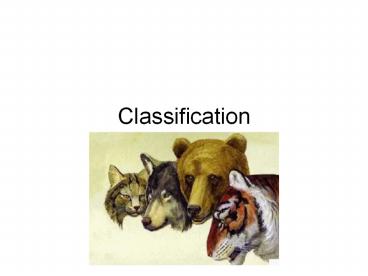Classification - PowerPoint PPT Presentation
1 / 24
Title:
Classification
Description:
Classification I. Classification -the arrangement of things in groups of similar items. -scientists classify living things to describe what they are like and how they ... – PowerPoint PPT presentation
Number of Views:232
Avg rating:3.0/5.0
Title: Classification
1
Classification
2
I. Classification
- -the arrangement of things in groups of similar
items. - -scientists classify living things to describe
what they are like and how they are related to
other organisms. - - without classification, scientists could not
share information about organisms. - there is no correct classification system
for living things.
3
- An organisms structures and features are
important characteristics for classification. - -ex. Fish are classified by the shape and
position of their fin.
4
- B. Scientists use cell structure and ways of
getting food to place organisms in to kingdoms. - C. Dichotomous Key is a powerful tool scientists
use, always gives two characteristics to choose
between, each choice leads to another pair of
characteristics. - -ex. tree
5
- D. Kingdoms
- -many scientists use six kingdoms today.
6
1. Bacteria separated into two kingdoms,
single-celled organisms, their cell does not
contain a nucleus, they can not be seen without a
microscope. -some of the smallest living
things. - there are more bacteria than any
other organism, and they live almost everywhere
on Earth.
7
- - Some types of bacteria are very useful.
- ex. Bacteria in your stomach and intestines
help you digest food.
8
- 1. Archaebacteria
- - meaning ancient bacteria
- - today they live under conditions that are
deadly to other living things. - -ex. Where there is no oxygen or heat is too
high to allow most forms of life to survive.
9
- 2. Eubacteria
- -generally can not survive in the extreme
conditions. - -ex. Ecoli
- -only have one cell, but cell functions are
quite complex. - -some use the suns energy to make food, others
get their food from eating living and non-living
materials.
10
2. Protists
11
- -have traits of plants and animals.
- -have more than one cell, most are
singled-celled organisms like bacteria. - -unlike bacteria they have a nucleus.
12
- animal-like protists are called protozoa.
- -take food from their surroundings and move
through their environment.
13
- plant-like protists are called algae.
- - use energy from the sun to make their own
food. - - they produce oxygen just like plants do.
- - some protists are microscopic, others can
grow very large.
14
- - perhaps the curious types of protists are
those that share characteristics of fungi. - they get food from their surroundings.
- some reproduce through spores as fungi do,
yet many can move.
15
3. Fungi
16
- -cells have a nucleus and a complex cell
structures. - range from one-celled organisms to huge
masses. - their cell walls are made of the same
substance as the hard shells of insects.
17
- -absorb their food, they decompose, or break
down, other organisms. - -fungi can not move, yet they grow quickly and
travel far away. - -reproduce by spores and they are carried by
wind.
18
4. Plants
19
- All plants are multi-cellular.
- almost all plants make their own food
- plants are classified according to the way
they transport water and reproduce.
20
E. Animal
21
- - Include an amazing variety of creatures.
- some swim, fly, or walk.
22
II. Ancient Classification Systems
- A. Aristotle, a Greek philosopher, who developed
the first classification system, in 350 B.C.
23
- B. World Explorers
- - returned from their travels with thousands of
new plants and animals. - - the invention of the microscope led to the
discovery of tiny forms of life. - the number of known living things increased
greatly.
24
- C. Carl von Linneus
- - a Swedish scientist, developed a new
classification system for organisms in the 1700s.































